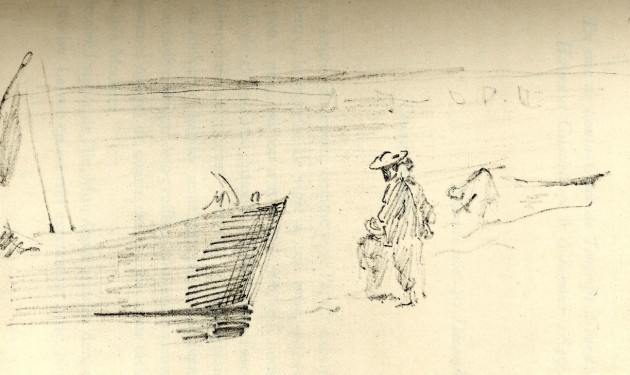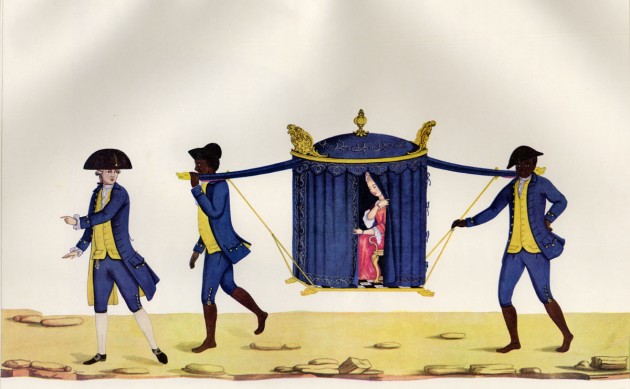Thursday, February 18th, 2016
Manet and Brazil

Edouard Manet, Porto Santo Island sketch, 1848. This sketch was sent to Manet’s mother in a letter, during Manet’s voyage to Brazil
One little-known fact about the painter Edouard Manet is that the artist traveled to Brazil as a teenager. When Manet was sixteen years old, he traveled to Rio de Janeiro aboard the Havre-et-Guadeloupe and subsequently spent several months in Rio. The point of his journey was to secure admission into the Navy and eventually pass the requisite admission exam, although neither of those things ended up happening. Travel conditions were difficult and the voyage took longer than anticipated: Manet left Europe on December 8, 1848 and docked in Rio de Janeiro on February 5, 1849. Poor Manet had to pass his seventeenth birthday while stuck at sea.
Manet was a really perceptive tourist and correspondent during this time traveling; his letters to his mother are full of very perspicacious observations, albeit that they are occasionally laced with stereotypical comments regarding Afro-Brazilians and Brazilian women. For example, Manet wrote that the nègres were “unfortunate men [who] seemed stupid.”1 As for women, he wrote, “Brazilian [colonists of European descent] women are generally attractive but don’t deserve the reputation of flirtatiousness attributed to them in France; no one is more prudish or stupid than a Brazilian woman.”2
He also made various observations about Brazilian culture, including that women were carried around in sedan chairs (perhaps similar to what Carlos Julião depicted a century before in a watercolor painting, shown above). Manet also visited churches in the area, though he didn’t enjoy the highly-lit gilt interiors. He found the churches to be in poor taste, writing that “they do not stand up to ours [in France].”3 One can imagine how the colonial Brazilian aesthetic must have seemed excessive to the French teenager! Manet must have visited a colonial church like the Igreja de São Francisco da Penitência (interior shown below), or one very similar in style.
Although some aspects of Brazil proved to be a disappointment (including the Carnival celebrations), the experience overall proved to be a positive one. Even some of Manet’s criticisms and cynical observations seem to have set the foundation for her later observations of modern life in France. Beth Archer Brombert observed along these same lines, writing, “A duality arose in him that would become a major factor for the modernism in Manet’s paintings. [Manet wrote:] ‘The Carnival is a very strange thing: I saw myself in it, like everyone else, as victim and actor‘ [emphasis added]. The germ of Manet’s future vision, as seen in works such as Music in the Tuileries and Ball at the Opéra, had already begun to grow in the seventeen-year-old.”4
Manet’s overall journey abroad lasted around six months: he returned to Paris on June 13, 1849. Although he didn’t end up having a career in the Navy, this trip did help to foster and encourage his interest in art. Manet wrote to his mother in one letter from 1849, informing her that he was invited to teach an art class to his companions on the ship, and explained “Here I a elevated to the rank of a drawing master; I have to tell you that I developed a reputation during the crossing. All the ships’ officers and all the instructors asked me to make caricatures of them. Even the captain asked for one to give his family as a Christmas present.”5
In retrospect, translator Jean Marcel Carvalho França has said that Manet was one of the most significant individuals to set foot on Rio de Janeiro soil during the nineteenth century. (Which is why, I assume, that the Praça Manet, a public square with soccer fields in Rio de Janeiro, received its name?) You can read more about Manet’s impressions of Brazil in a Portuguese publication, with more information found HERE.
1 Ana Lucia Araujo, Brazil Through French Eyes: A Nineteenth-Century Artist in the Tropics (Albuquerque: University of New Mexico Press, 2015), p. 76. Available online HERE.
2 Beth Archer Brombert, Manet: Rebel in a Frock Coat (Chicago: University of Chicago Press, ), p. 28. Available online HERE.
3 Ibid.
4 Ibid., p. 29
5 Ibid, p. 28


I’m guessing Manet was rejected by at least one Brazilian woman! 😉